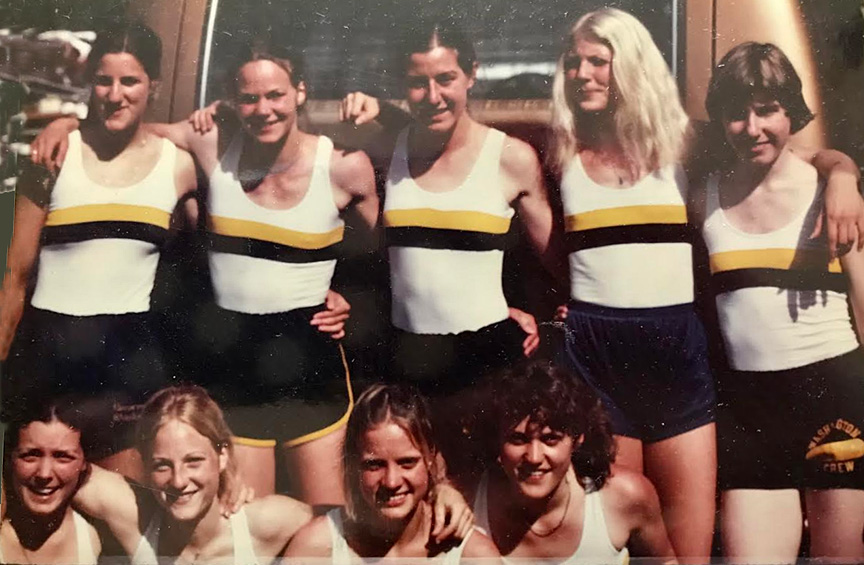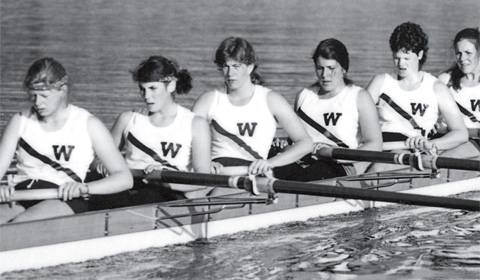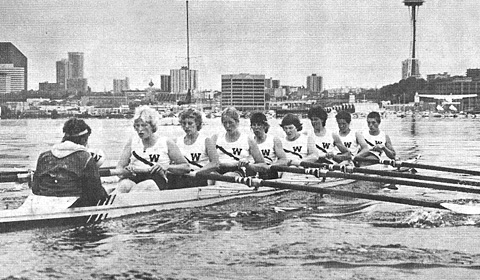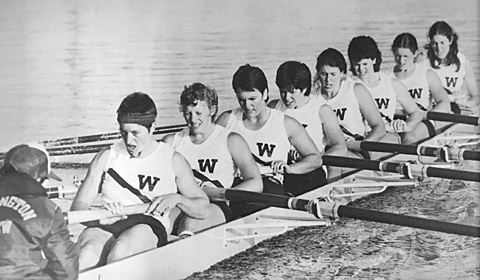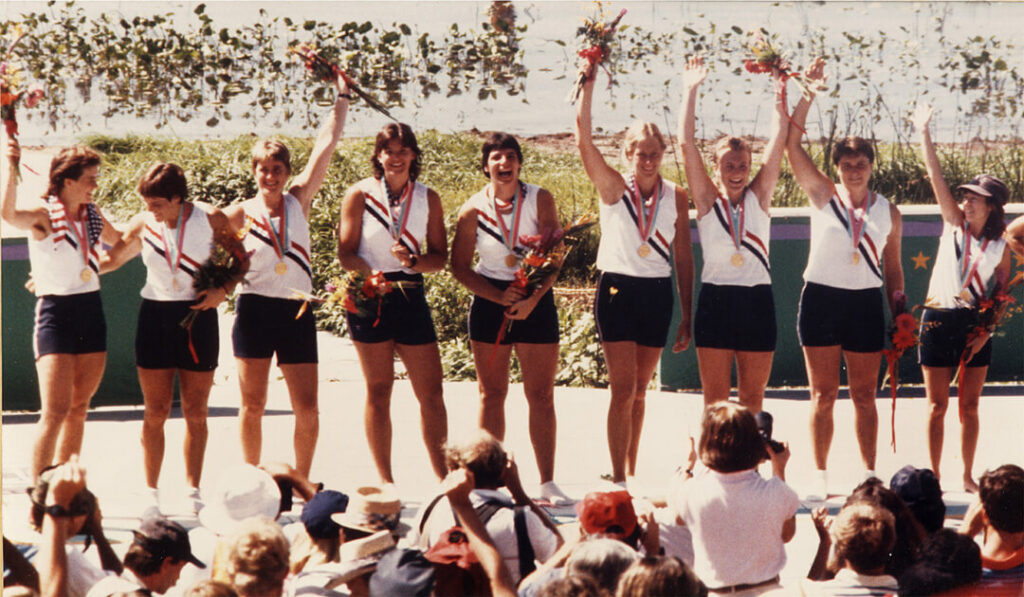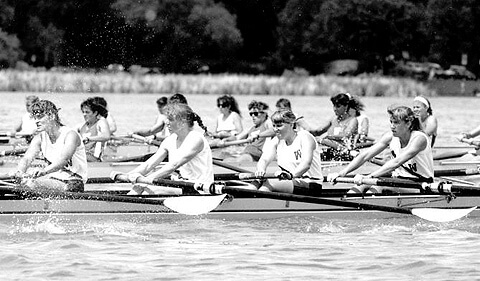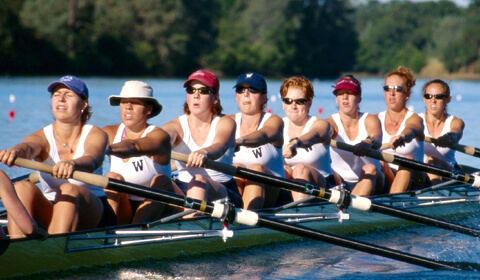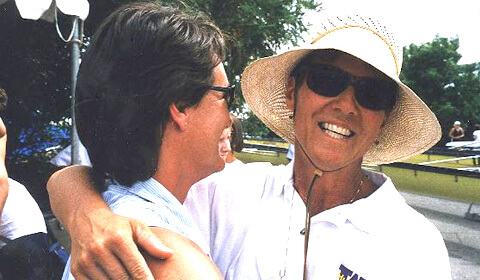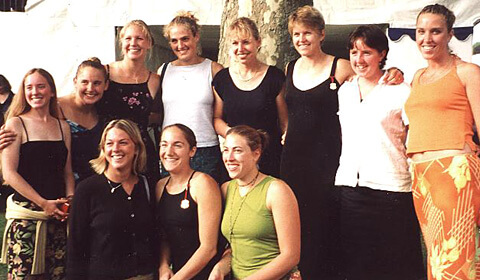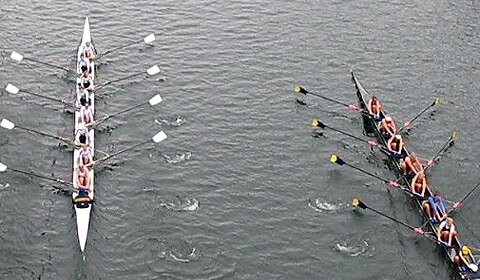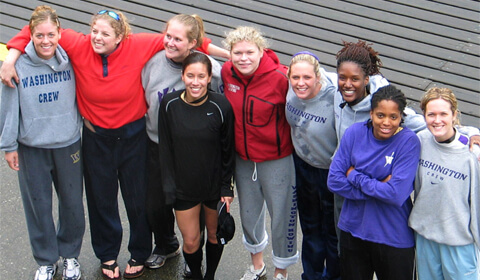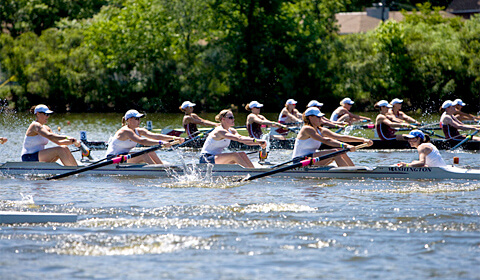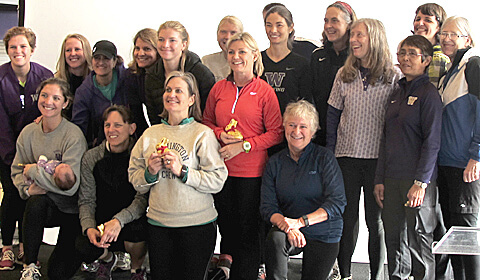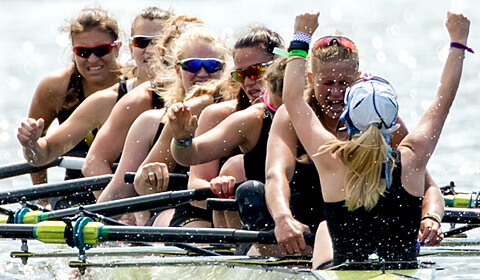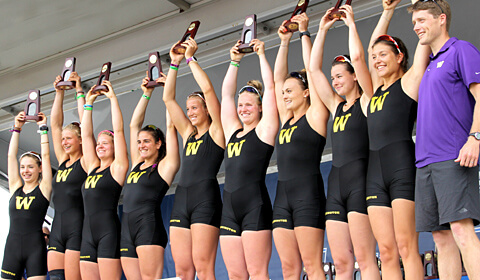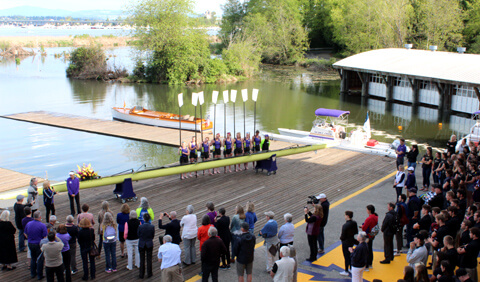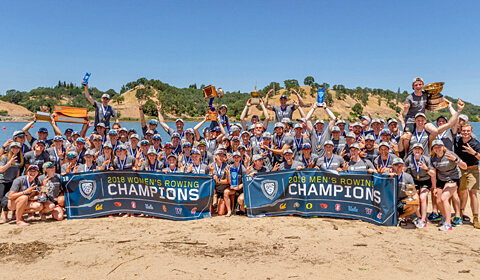Washington Rowing
Women's History

1903 is the first year of documented women’s rowing at Washington, with a photo and page in the 1904 Tyee that noted, “The co-eds have taken to rowing for the first time this year. A number of the young ladies of the dormitory may be seen each morning about six o’clock down at the lake training faithfully. They use the same boats used by the boys and under the same conditions.”
A number of factors played into this opportunity. For one, the new campus was surrounded on two sides by water, Lake Union to the west and Lake Washington to the east, and rowing was a natural attraction. But another important factor was the frontier spirit at Washington; to a large degree, Washington was not influenced by east coast “norms” or culture. Their culture was their own, and it was borne out of a closeness to nature, bountiful natural resources, and a location hundreds of miles from the next major urban center. The Washington identity was whatever they made it.
And make it they did. Importantly, as part of that new identity, 1903 also marked the inaugural “Junior Day”; what through the decades is now continued at Washington as “Class Day”. As described in the early history, “Junior Day” was a university-wide program that included rowing and canoeing (aquatic sports), basketball, athletics (track and field), tennis events as well as other University activities such as log rolling. Both men and women competed in the sports events and at times they competed together in mixed events. The activities and sporting events pitted each class against the other for bragging rights. In addition, each year the junior class planted a tree in front of present day Denny Hall with Professor Edmund Meany, and wrote and performed a farce play. The Junior Day events – sometimes lasting several days – usually ended with the Junior Prom. Although there is no record that the women of 1903 competed in rowing in the first ever Junior Day (May 1, 1903), we do know that efforts were being made for oarswomen to be a part of this unique all-campus event.
Washington Rowing History – Women: 1900’s, with the program really hitting its stride after 1910 – Washington Rowing History – Women: 1910’s.
Women’s organized rowing was unique at the time and in many ways defines the University’s innovative spirit from a young age; but so too is the opportunity to read about it. We hope you take the opportunity to read this exceptionally researched history that Ellen so eloquently wrote to fully understand the legacy – and importance – of the early years of Women’s Rowing at Washington. Tyee photos

Hiram Conibear was hired in the fall of 1906 as a trainer for the track and football teams and – after Jim Knight vacated the rowing job – was convinced by the athletic board to also assume the role of head coach for “aquatics” (rowing) for the 1907 season. With some women already informally rowing out of the boathouse, Conibear made it official and started a women’s program, the only one of its kind at a public school in the nation at the time. Conibear – an innovative, intelligent, curious, determined risk-taker – believed in four core principles: hard work; team over self; camaraderie; and rowing to win. Here he is pictured (in the back), early in the establishment of this team, with five of his athletes. Tyee photo

The magnitude of what these women, along with their coach, were accomplishing by maintaining a daily regimen of rowing at a university at this time cannot be understated. In 1907 – when this photo was taken – Theodore Roosevelt was President of the United States; Oklahoma, New Mexico, Arizona… were not states, and women could not vote (women would win that right through the ratification of the 20th Amendment thirteen years after this photo was taken in 1920). There were two women’s rowing programs active at U.S. universities at the time: Washington and Wellesley. Women’s athletics were not only unsupported in the majority of the country, they were often admonished as unhealthy for women, particularly in endurance and aerobic sports.
Hiram Conibear did not agree with that sentiment. He encouraged women to row and fought for it multiple times, even risking his job by ignoring an administration that saw women’s rowing as dangerous and unflattering to women. Women’s Rowing was cancelled by upper campus more than once, but each year would come back with the blessing of Conibear, to the point where by 1913 he was hiring a woman to be the women’s head coach. And although formal competition (once a year) was limited to “form contests” competed by class (awarded points by judges for composure, synchronicity, posture, and bladework), informal competition was completely different. As we know from testimonials, that was less an annual event, but much better described as a consistent event: when the women headed out into Lake Washington or Lake Union – and this is particularly true after 1912 when the program had more shells – they went head to head full slide, full power.

A July 17, 1910 article in the Seattle Daily Times describing the conflict Hiram Conibear was already having with upper campus over his women’s team. Miss Jessie Merrick, the phys-ed director for women at the UW, was adamantly opposed to the “rigorous exercise which Conibear prescribes for them”, and denied Conibear and his athletes the racing they wanted, adjusting practices to instead focus on a form contest. “Miss Merrick contended that the rigorous treatment “Conny” was giving his fair proteges was too violent and that his language was ungentlemanly,” the article stated. “She protested, particularly against the long race which “Conny” wanted the women to pull off on Junior Day. The result was that the women did not race, holding what was known as a ‘form-race’ instead”.
There is a lot packed into this article, but it is important to note that “the women petitioned the UW to allow them to take rowing and the board granted them permission. Miss Merrick has since declared that she will not allow the women to take the rigorous exercise that Conibear prescribes for them, so that present plans have been brought to an abrupt halt.”
This would not be the first – or last time – “Conny” would find himself defending the women’s program, and particularly these early women athletes who wanted to race. Seattle Daily Times, July 17th, 1910

Women’s athletics at Washington was not limited to rowing; in fact, basketball, baseball, hockey, and track became sponsored sports for women. But by 1912 women’s rowing was attracting as much as 10% of the entire coed population on campus, with a program growing so rapidly that everyone – including upper campus – were taking notice. Tyee photo

Two of the more influential women whose coaching led to the growth in the sport at Washington: Gretchen O’Donnell (l) and Ethel Johnson (r).
O’Donnell is described in the history: “In addition to her dedication to rowing, Miss O’Donnell was on the Hockey team (right halfback) and Basketball team (guard), as well as being assistant editor of the Tyee, member of the Women’s League, WAA, Spanish Club, Senior Class Secretary, Varsity Ball Committee, involved in drama, and Senior Class historian. Add to that “coach” of the women’s rowing squad in 1911; invaluable to Conibear in these early years, it was her dedication that linked the program from it’s inception to the glory years mid-decade.”
Johnson took over the head coaching role in 1913, “hired by Jessie Merrick as coach/instructor for Hockey and Baseball, and quickly took to the sport of rowing.” Tyee photos

As the community continued to support the program, more equipment was purchased, and more women joined the team. From Ellen’s history:
“Coach Conibear recalled the days when the girls started to row in ’06, when they had to tramp through the snow to the old canoe club and row in a stationary boat under a leaky shed, from which all the water drained onto the rowers. ‘We owe everything we have,’ said Connie, ‘to our friends in the city. The ASUW pays the salary of the coach, but all our equipment has been given us. In the spring we are going to ask for new shells, for we are in urgent need of new equipment, and we hope that then we will have more men and women out.’” (The UW Daily, December 7, 1914)

From the Seattle Star, February 3rd, 1914, an article featuring Lucy Pocock (sister of George and Dick) and her addition to the coaching staff at Washington. “Miss Pocock believes the English stroke is the best and is teaching it to the girls of the freshmen eight. She promises to give the older crews a hard run for the class championship,” states the article. Thank You Al Mackenzie and Seattle Star; added 3/23
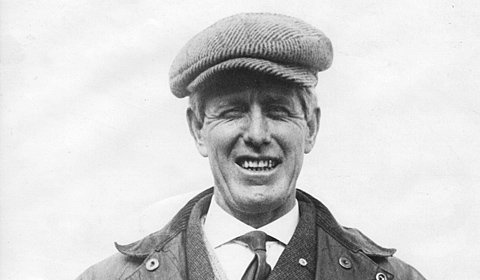
Always the optimist, always the believer, and always – like Dick Erickson some 70 years later would say – an “opportunitiest”, Hiram Conibear was killed in a freak accident in his backyard picking plums in September of 1917. That same year the U.S. had entered World War I, and suddenly a perfect storm of circumstances was weighing on the program. Washington Rowing – in a matter of months – was abruptly and irrevocably changed. By the time the war was over a year later, rowing across the country was being redefined, but none more so than on the west coast. Cal’s men’s program was teetering on the edge of extinction, and Stanford’s men’s program was cancelled and would not return for 60 years (neither of these programs ever had women’s rowing to begin with). As Ed Leader took over at Washington, it was all he could do to keep any rowing alive against a backdrop of anti-athletic sentiment on upper campus, and a community reeling from the war. In those years of turmoil one of the greatest casualties at Washington was women’s rowing. Without their strongest advocate in Conibear, and without the funding or the facilities as the men’s team moved to the Navy Hanger on the new Montlake Cut, women’s rowing – and the unique opportunity it afforded the many young women who participated – would disappear from campus for decades.

Following the death of Hiram Conibear in 1917 – the lifeblood of the early women’s rowing program at Washington – and the post WWI changes on campus, women’s rowing took a decades long hiatus at Washington. It was not until after WWII that rowing began to re-emerge as a physical education alternative for women; here are some of the earliest young athletes trying out the sport as an IMA offer in Old Nero, launched from the ASUW shellhouse in the spring of 1949. UW Archives photo

Joan Bird was the catalyst in the re-birth of Women’s Rowing at the University of Washington in the fall/winter of 1968. A transfer from Mills College where she rowed, Bird was surprised to find the UW had no such program for the women at the UW. “I first visited Norma Carr down in the Intramural Building to sign up for women’s crew and was surprised when she told me there was no such thing,” Bird said in an interview with the Helena (Montana) Independent Record in 2010. “She said it was because there was no interest, but when I told her how much I’d enjoyed the sport and couldn’t believe there wasn’t interest, she volunteered, with a conspiratorial smile, ‘If you can demonstrate there is an interest, the university is obligated to supply you with equipment.’”
An interest there was. Thirty women signed up and coach Bernie Delke was hired as the intramural coach, the women borrowing the intramural men’s equipment (wherry fours and eights) on Tuesdays and Thursdays. In April of 1969, they entered their first race at the Corvallis Invitational at OSU, driving their own cars south with oars strapped to the roofs, and borrowing racing shells (actual shells, not wherries) and for the first time attempting to set the boats on the way to the starting line. It was an adventure, but by June the team was rowing in shells borrowed from the men’s team, and subsequently raced at the NWRA Nationals on Greenlake, placing 3rd in both the lightweight 4 and lightweight 8 events.
Ellen Ernst, who wrote the detailed UW early year history, added, “Participation in the 1969 nationals ended the rebirth year, and the first racing season for the UW women’s crew. Joan Bird had the vision and energy to reintroduce the sport [and] the women were excited to continue rowing and competing — and in making up for the 50 years of lost time! They were hooked!” Thank you Helena Independent Record, June 16, 2010. Photo: UW Tyee, added 3/23

By the late 60’s, the women were an official club sport at Washington and were becoming more organized, with a new head coach in Bernie Delke. The 1969 Women’s Varsity Club team, back row: Alice Anderson, Carol Owens, Susan Cook, Linda Cles, Joan Bird, Marie Swanson, Jody Curry, Coach Bernie Delke; bottom row: Pat Gustke, Jan Richardson, Julie Johnson, Coleen Lynch, Jeanne Waters, Molly Skerbeck, Suzi Louie, Denise Etcheson, Penny Nattress. Tyee Photo

Over forty women were already making up the roster of the women’s team in 1969, including Cathy Kann in the two seat, and Nancy Engard rowing three in this photo from the UW yearbook.Tyee Photo

The 1970 novices out in Old Nero (with coach Delke in the stroke seat). The women rowed and trained out of the original ASUW shellhouse (known as the “canoe house” after the men vacated the building in 1950), so this photo would have been taken right after launch into Union Bay. The “canoe house” was dark and cold and the dock was small, but that did not dissuade these club athletes from learning and competing in the sport. Out of this team came the first NWRA National Championship for the UW, in the 1970 Lightweight 4+. Tyee Photo
A series of photographs from May of 1970 when Terry Drinkwater, the CBS National News west coast correspondent, brought his CBS TV production team out to Seattle to film the nascent women’s rowing program at the UW. The impetus for this visit was an April 1970 article in the Christian Science Monitor, written by UW Communications writer Mary Ellen Campbell, titled “To be a part of that motion, grace; It’s the reason why young ladies are rowing”.
In the article Campbell explains that the new program, led by Coach Delke, has 42 current athletes, that the team launches from the “Canoe House” (the contemporary term for the original ASUW shell house on the Cut), and that practices begin at 6:30 a.m. “Unlike European women’s teams, American women are just beginning a crew program,” the article states. “There is much organizing necessary. Development of facilities and acquiring the elaborate equipment for rowing takes time. But the University of Washington girls are excited about blazing the way.”
“When it goes well everyone knows it. It feels good. That good feeling is both the goal and the reward for the rowing. It takes work; the yellow shirts worn by the women’s crew were a familiar sight in the weight room of the Intramural Building all winter. Working on weights, coupled with running to build endurance and wind, the team awaited spring weather to begin training on the water once again.”
In the photos above the original yellow shirts – paid for by the women themselves – can be seen as the women launch from the shell house. The wherry shells were carried out of the double doors in the back of the building and walked over to the east facing docks of the Waterfront Activities Center where the team launched. A young Bernie Dehlke is seen talking with Drinkwater at the shell house, and as the team is filmed near Fox Island at the eastern end of the Cut.
The CBS production gave the sport and the UW program significant national exposure at a time when rowing was just emerging as a competitive alternative for women. That summer, on Lake Merritt in California, the UW women won their first National Championship, in the Lightweight 4+. Thank you Christian Science Monitor, April 23, 1970; photographs and sourcing thank you Al Mackenzie; added 3/23

The 1971 National Champion Lightweight 8 at the 1971 NWRA Nationals in Old Lyme, Connecticut, holding the NC trophy: in front (with trophy) is coxswain Marilynn Goo, and per Marilynn the following: Jean Turney is standing in back with the sunglasses and camera; front – Coleen Lynch, Pam Hall, and Randi Mattson. Mary Lou Talbot is behind Pam and Randi; Paula Mitchell is in the hat and sunglasses behind Randi, with Ann Pace next to her.
These early teams were not funded by the University, so they were on their own when it came to travel, coaching, operational/daily expenses… even down to the uniforms. “As a club sport, we did not receive university issued uniforms”, said Marilynn. “Someone would go buy shirts and then take them to have the UW Women’s Crew logo printed on them… I remember going with Jan Holman (Jan Harville) and someone else to J. C. Penney where we bought the purple henley shirts for the 1972 racing season.”
“Kit Green (UW Assistant Athletic Director) was very supportive but I don’t think the University contributed much since we were a club sport. The fundraiser that I remember is selling crew buttons. We had some buttons made to sell and on Opening Day we would take out canoes from the canoe house (the original ASUW shellhouse on the Cut) so that we could sell them to the people lined up to watch the races. We also had people working the crowds on land.”
This 1971 team dominated the lightweight events at the NWRA’s in 1971, winning the lightweight single, lightweight 4+ and the lightweight 8+ at Nationals. Thank you Marilynn Goo

The 1972 lightweight 8 with the repeat National Championship performance at the 1972 NWRA’s: Back row: Liz Senear, Gigi Coe, Pam Gilmore, Susan Karpiak. Front row Randi Mattson, Jackie Frye, and coxswain Marilynn Goo. The UW lightweight quad also won the National Championship in 1972. Photo: thank you Marilynn Goo
The three photos above are all from the scrapbook of Debby Tonge Jackson ’73 (pictured 2nd from left in the 1972 Open 4+ above, and third from left in the Open 8+). “There are a lot of crew memories for me but the most important is the legacy of being an athlete for the first time ever,” said Debby. “I went to Roosevelt High School in Seattle when there weren’t any sports for girls – and I never figured I was cool enough to be a cheerleader. I always figured I would attend the UW, and in the fall of my junior year, I read in The UW Daily about a meeting for women interested in joining crew. I decided I wanted to meet other girls and to join a group, though I thought maybe I was too big – which I learned was pretty funny since I was 5’5” and about 132 lbs. Turned out I did pretty good in the weight room (especially the leg press) and Bernie Dehlke, our coach, had me row heavyweight. I think I was pretty proud of that.”
She continued: “I remember traveling to Corvallis to race… we heavyweight girls ate ice cream at the drive-in but the lightweights couldn’t since they had to weigh in, and I remember the drive home from Corvallis one year at night when it was my turn to drive… and I didn’t really drive much at all usually. I remember Nationals in 1973… first to Philadelphia where we got to go upstairs in the 747 airplane, and stayed at the Benjamin Franklin Motor Inn and rowed on the Schuykill River, and wandered around Philly and saw the Row Houses and Delis that were so different from Seattle. We stayed after the regatta to sightsee in Washington DC, driving around in Randi Mattson’s red VW van during a huge rainstorm, and sleeping overnight in a National Park on the outskirts of DC.”
“I loved the camaraderie with the other women on the team and I loved Bernie (Dehlke, head coach), but mostly I loved the rowing. And I still do all these years later. It truly is a beautiful sport! So, I guess I’d have to look up the details of the race times, lineups, and medal counts… but it seems it’s the team and the sport that stick with me all these years later. Rowing is probably the best thing that has ever happened to me and it’s made me what I am; I even met my husband through a teammate, had two great children (who both rowed in high school, and my daughter for two years at UW), and now am a happy grandmother, all thanks to rowing.” Photos thank you Debby (Tonge) Jackson

The 1973 Washington Varsity Lightweight 8 on Greenlake for the spring regatta… Photo: thank you Marilynn Goo

…and together on the docks at the NWRA Championships in Philadelphia with the third National Championship in a row, left to right: Mary Dion, Dena Peel, Barbara Mitchell, Marylou Talbot, Chris Satterlee, Julie Gustafson, Randi Mattson, Kathy Roberts, and coxswain Laurie Bennett. Photo: Washington Rowing

The 1973 Open 4+, left to right: Liz Senear (stroke), Jan Holman (3), Joanne Williams (2), Debby Tonge (bow), and Marilyn Goo (cox).
By 1973, the UW Athletic Department (via Assistant AD Kit Green) was providing airfare and hotel rooms for the women athletes. “I am pretty sure the trip to Philly was paid for by the UW,” said Debby (Tonge) Jackson. “I know neither I nor my parents paid — I was totally awestruck by that! I think I escaped a lot of the hardcore fundraising, maybe because I only rowed my junior and senior years.” Photo: Thank you Debby (Tonge) Jackson

In the fall of 2020, BJ Connolly – a rower now for decades – wrote a memory for the LWRC newsletter and shared it with us. The corresponding photo is in that same timeframe (1973 vs 1975), and gives a visual representation of the days when Dick Erickson would take his team through the locks and out into Salmon Bay. Here is what she wrote:
“Human-powered vessels typically don’t venture through the Ballard Locks. And Husky crews usually don’t head for open water of the saline variety either. But one day in the spring of 1975, two worlds converged.
But first, step back in time to 1972-73. It was my freshman year, and Washington won the NWRA National Championship on the Schuylkill River. With that accomplishment, we realized that the UW was beginning to embrace the ideologies of Title IX. We were in the thick of it, trying to work with the men’s team to continue to be recognized as a varsity sport despite the decades of male dominance and tradition that permeated the aura of Conibear. The saving grace for women’s crew? Head Coach Dick Erickson, who absolutely loved the idea of having women row for Washington! He wholeheartedly supported our efforts, providing launches for our coaches and designating one boat bay for us.
Dick’s encouragement gave senior rower Liz Senear and me the courage to ask him if we could convert one of the men’s pairs to a double. Liz had set her sights on making the U.S. National sculling team for the World Championships in 1975. With a double, we could train every day. The guys thought, “What?” But Dick supported us. And he loved being controversial, always keeping the men guessing. So, he found old sculling riggers at the Pocock workshop. Boom! We were in business!
One day, we learned the men (including my future husband, Mike) were going to row to Shilshole Bay via the Ballard Locks. We asked Dick if we could join the fun. Leading the way to keep some distance from the eights, we entered the locks. Imagine all those shells in such a tiny space! Oars overlapping. Anxious coxies avoiding the walls. Lockmasters barking orders while the water was slowly released to the west and we went down, down, down. Dick positioned our double in the middle of all the eights for protection. What a spectacle for the crowd! It was hysterical to hear some of the rowers perfectly imitate the Scottish accent of one of the lockmasters. Even Dick chuckled, totally enjoying the moment.
It was a once-in-a-lifetime event! And Liz did attend the World Championships as a spare for the U.S. quad!” 1973 VBC Yearbook photo

Title IX was signed into federal law in 1972, the result being women’s rowing officially established as a Varsity sport at the University of Washington in 1975. Here, that Varsity Team practices on a glassy Lake Union in 1975, Gasworks in the background. Kate Camber photo

Kit Green was hired by the University of Washington as a PE instructor in 1960. By 1969, she was administering the IMA and overseeing women’s club teams at the UW, including the IMA rowing team, in an office that “resembled a closet” according to the Seattle P-I in a 2007 article on her legacy. Brought under the Athletic Department umbrella in the early 70’s, it was Kit who helped fund the women’s team even before Title IX changed the landscape. By 1975 – as the newly established Senior Associate Athletic Director for women’s sports at Washington – Kit was integrating eleven women’s club teams into the varsity program at the UW.
“At the outset, only limited funding was provided by the University,” Kit said in a 1999 interview when she received the Nike Lifetime Achievement Award for Women in Sports. “We started with no scholarships, no lockers, part-time local coaches, no trainers, one set of uniforms, private cars or school buses for transportation… just the bare bones.” She added in 2007, “I do remember the beginnings, and they were tumultuous.”
But through her commitment, by 1980 women’s varsity sports were fully established on an equal footing at the UW. It was through her leadership that every facet of the rowing program at Washington met the same standards as the men, overseeing the steady growth of the sport and ultimately a run of National Championships that remains unprecedented today. “I am proud of the fact that I was able to persevere and survive under often difficult circumstances, including a sometimes hostile environment, and was instrumental in creating a viable program of intercollegiate athletics for women at Washington,” she said in 1999.
Kit Green’s influence and impact on women’s athletics – holistically – cannot be understated. She was a pioneer at Washington, but also regionally and nationally recognized as one of the early adopters and “change agents” for equality in athletics. Her unwavering desire and positive energy that she brought every day to her job is still felt today… and none more than women’s rowing at Washington, a sport and team that she so deeply valued from the very beginning. UW Athletics photo; Thank you to The Tyee Difference, spring 2022, and the Seattle P-I, April 5, 2007

At the 2022 Henley Royal Regatta, the Washington Varsity 8 raced in the Remenham Cup (the top event for women) in a brand new Empacher eight named the Kit Green, in honor of Kit and her influence on the program still felt today. “It was an honor and a privilege to race in the Kit Green at Henley, just in time for Kit’s 90th birthday, Title IX’s 50th anniversary, and in the midst of Henley’s continued expansion of women’s events”, said UW Women’s Head Coach Yaz Farooq. UW Rowing photo; added 2/23
On April 22nd, 2023, the Kit Green was officially launched after the annual UW/Cal Dual Regatta, with Kit christening the shell with finish line water from the Montlake Cut, and toasting the Varsity 8 that had – about an hour prior to these photos being taken – won the Simpson Cup on the Cut. “I’m really happy with that result,” said UW head coach Yasmin Farooq. “What made it extra special was that they raced in the ‘Kit Green,’ which we dedicated today. Kit was in the coaches’ launch with me and got to watch the whole race.”
“We have been so fortunate with all of the support of all who came before this generation, beginning with the women from the 1970s, who started the Title IX endowment in honor of the 50th anniversary,” Farooq continued. “For us to be able to race in that boat with Kit watching made it a really great day.” HRF Photos/added 4/23

In the spring of 1975, in the first year that women’s rowing was re-established as a varsity sport at Washington, the UW women launched their first new shell since the days of Hiram Conibear, and it was aptly dedicated to Dolly (McLean) Callow ’13. Callow was a consistent figure in the rebirth of women’s rowing at Washington, and is seen here (center) with Lucy Rochester (left) and Karen Anderson (right) at Seward Park prior to the boat dedication. Callow, in her days as a rower with Hiram Conibear as her coach, told Al Ulbrickson Jr. in his 1963 history compilation: “While the girls’ program was not supposed to be competitive in the least, it was not unusual for two or more girls’ crews to compete unofficially when out of sight of the boathouse…” For this new team, her competitive spirit and connection to the past were highly inspirational; and as the women set out in the spring of 1975 to lay the foundation for teams to come, it was that same alumni tradition — to support and inspire — that is at the heart of our values today. Thank you Kate Camber ’78 (Kathy Bulger) for the photo

The women’s team on the Conibear apron with the brand new Dolly Callow. “The first race in the Callow was a victory for the lightweight eight,” said Kate Camber of the victory at the NWRA Regionals, June 1, 1975. “The Callow was Stan’s first attempt to make an eight for women… it had so much flex, only lightweight women could row it, much to the lightweights’ delight.” Thank you Kate Camber ’78 (Kathy Bulger) for the photo

The combined (open and lightweights) women’s team collecting the overall team points trophy – from Stan Pocock – at the 1976 Western Regional Collegiate Women’s Rowing Championship. Kate Camber photo











